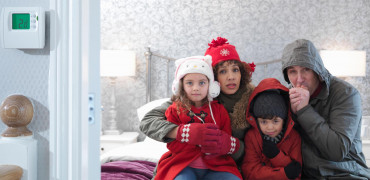The Spring Budget was a missed opportunity to convert more of our cold properties into energy efficient homes
Just before the Spring Budget, one of the country’s leading research establishments issued a report showing the strong correlation between standards of housing and the cost to the NHS of treating residents for various conditions.
This should have prompted the chancellor to change some of his plans and invest in a major programme to upgrade levels of insulation in the nation’s homes.
Such a move could also have made serious inroads towards achieving our net zero carbon emission targets by reducing our reliance on gas and oil fired boilers to heat our cold and leaky homes.
Heating our homes currently accounts for an estimated 14% of our carbon emissions.
Analysis by the Building Research Establishment (BRE) showed that over 700,000 homes in England are defined as ‘excessively cold’ and the NHS spends over £540 million a year treating people affected by the worst properties.
These properties are poorly insulated and inadequately heated. The BRE estimates that investing in repairs and upgrades to these properties would be paid back within nine years through savings to the NHS.
Improving people’s lives and health while reducing NHS pressures and cutting carbon must surely be attractive
Spend to save
Excess cold is most prevalent among the 500,000 owner occupied and 200,000 privately rented homes that are more likely to have the lowest energy efficiency ratings (in bands F and G).
When broken down by tenure, BRE estimates that it would cost an average of £6,690 to remedy excess cold for an owner occupied property and £6,835 per property in the privately rented sector.
There is a Government policy already in place which requires landlords to improve excessively cold private rented properties, but it has limitations and some serious flaws.
Under minimum energy efficiency standards (known as MEES), landlords need to bring their rentals upto a minimum of band E but they only need spend a maximum of £3,500 on improvement works.
The BRE research estimates that this sum is only sufficient to bring between 30% and 40% of the coldest homes, up to the band E standard.
In view of this the BRE is calling for a strategic retrofit programme that directly targets investment towards the least energy efficient homes – through cost effective solutions like roof and wall insulation and heating system improvements.
It says such investment could deliver relatively rapid savings for the NHS, freeing up health funding for desperately needed spending in other areas.
Gillian Charlesworth, chief executive of the BRE, said: “These results are just the tip of the iceberg. The £540 million cost to the NHS of treating health problems associated with cold homes is only part of the picture. Many of these people will be unable to work and potentially will have to remain in hospital for a long time if their home isn’t safe for them to return to.”
Commenting specifically on the Budget, she added: “Decarbonising our stock needs to form a core part of the green transition, to bring energy use and prices down significantly and bolster the efficiency of our buildings.”
Linked investment programmes
The Government is currently struggling to deliver on its boiler upgrade scheme, which aims to incentivise house owners to switch from oil and gas fired boilers to heat pumps.
The scheme has recently been extended but originally had a budget of £150 million each year for three years and aims to install 30,000 heat pumps annually. However, in the first eight months of operation, only 9,888 grants were awarded.
The budget could have included a bold fresh programme promoting heat pump uptake and other energy efficiency opportunities like building insulation, but this was another opportunity missed by the chancellor.
The absence of joined up energy programmes and the high cost of energy is seeing changes in the behaviour of private tenants. More and more of them are looking for all-inclusive rents when searching for somewhere to live, according to property portal Rightmove.
In fact the phrase "bills included" is now second on the list of search terms (after pets), having been fourth a year ago, reflecting the pressure of surging prices.
“Tenants have shown through their search behaviour how appealing a home with bills included could be. Any landlord who is able to offer this added incentive is likely to be met with an orderly queue of ready-to-go tenants to choose from” according to Rightmove’s Tim Bannister.
High cost rentals
This shouldn’t surprise us because private rentals are among the coldest and most expensive homes in the country to heat.
Citizens Advice says the average private sector tenant in England is paying £350 more a year on heating because of poorly insulated and damp homes, while those in the least efficient properties are paying an extra £950.
It is also calling on the Government to bring the private rented sector into line with new rules for social housing. Awaab’s Law is due to place “strict, legally binding timelines” on councils and housing associations to deal with serious issues such as damp and mould.
The idea that we can improve people’s lives, improve their health and the condition of their homes, while also reducing pressures on the NHS and at the same time doing our bit to cut carbon emissions is surely an extremely attractive proposition.
In fact you would be forgiven for thinking that it is so attractive, a senior politician would surely see the sense in it and decide to pursue it, particularly when their party are languishing in the opinion polls. We’re still waiting to see if Mr Hunt will let the penny drop!
Patrick Mooney is news editor of Housing Management and Maintenance magazine


